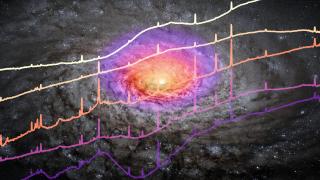Bibcode
Pierce, J. C. S.; Tadhunter, C.; Ramos Almeida, C.; Bessiere, P.; Heaton, J. V.; Ellison, S. L.; Speranza, G.; Gordon, Y.; O'Dea, C.; Grimmett, L.; Makrygianni, L.
Referencia bibliográfica
Monthly Notices of the Royal Astronomical Society
Fecha de publicación:
6
2023
Número de citas
43
Número de citas referidas
39
Descripción
The triggering mechanism for the most luminous, quasar-like active galactic nuclei (AGN) remains a source of debate, with some studies favouring triggering via galaxy mergers, but others finding little evidence to support this mechanism. Here, we present deep Isaac Newton Telescope/Wide Field Camera imaging observations of a complete sample of 48 optically selected type 2 quasars - the QSOFEED sample ($L_{\rm [O\, \small {III}]}\gt 10^{8.5}\, \mathrm{L}_{\odot }$; z < 0.14). Based on visual inspection by eight classifiers, we find clear evidence that galaxy interactions are the dominant triggering mechanism for quasar activity in the local universe, with 65$^{+6}_{-7}$ per cent of the type 2 quasar hosts showing morphological features consistent with galaxy mergers or encounters, compared with only 22$^{+5}_{-4}$ per cent of a stellar-mass- and redshift-matched comparison sample of non-AGN galaxies - a 5σ difference. The type 2 quasar hosts are a factor of 3.0$^{+0.5}_{-0.8}$ more likely to be morphologically disturbed than their matched non-AGN counterparts, similar to our previous results for powerful 3CR radio AGN of comparable [O III] emission-line luminosity and redshift. In contrast to the idea that quasars are triggered at the peaks of galaxy mergers as the two nuclei coalesce, and only become visible post-coalescence, the majority of morphologically disturbed type 2 quasar sources in our sample are observed in the pre-coalescence phase (61$^{+8}_{-9}$ per cent). We argue that much of the apparent ambiguity that surrounds observational results in this field is a result of differences in the surface brightness depths of the observations, combined with the effects of cosmological surface brightness dimming.
Proyectos relacionados

Actividad Nuclear en Galaxias: una Perspectiva 3D del Núcleo y su Entorno
Nuestro proyecto puede dividirse en dos líneas principales de investigación. En primer lugar, el estudio de los vientos producidos por cuásares luminosos oscurecidos y del impacto que estos tienen en sus galaxias anfitrionas (retroalimentación del AGN). Para ello hemos obtenido observaciones en el óptico e infrarrojo cercano con el Gran Telescopio
Cristina
Ramos Almeida